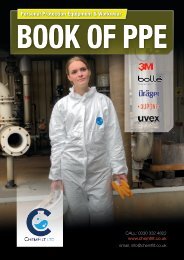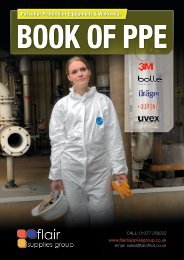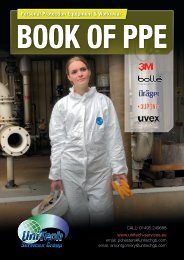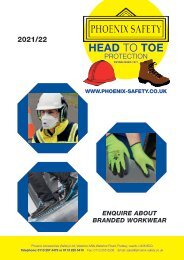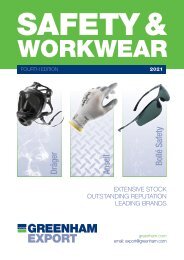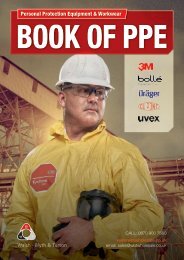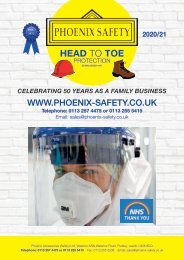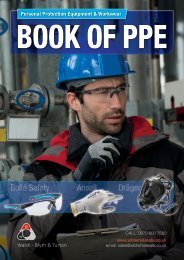Larchfield PPE Catalogue
Create successful ePaper yourself
Turn your PDF publications into a flip-book with our unique Google optimized e-Paper software.
Respiratory Protection<br />
Buying Guide<br />
Selecting the correct protection<br />
The selection of Respiratory Protection follows a basic four-step method:<br />
• Identify the hazards – dust, metal fume, gas, vapour<br />
• Assess the hazards – assess the hazard level/other protection – skin and eye<br />
• Select the proper respirator – disposable, half mask, full face, powered, airline<br />
• Training in fitting and use – to optimise respiratory protection<br />
FILTER MARKINGS<br />
For use<br />
against<br />
Gas and<br />
Vapour<br />
(EN 14387<br />
and<br />
EN 405)<br />
Particles<br />
(EN 143<br />
and EN 149)<br />
Filter Colour<br />
Type Code Main Applications<br />
A Brown<br />
Organic Vapours with boiling point greater<br />
than 65˚C and good warning properties<br />
B Grey<br />
Inorganic gases and vapours, E.g. Chlorine<br />
(not Carbon Monoxide)<br />
E Yellow<br />
Acid gases and vapours, E.g. Sulphur Dioxide,<br />
Hydrogen Chloride<br />
K Green Ammonia and organic ammonia derivatives<br />
P White Particulate<br />
Hg Pink Mercury Vapour<br />
AX<br />
Brown<br />
Dusts<br />
Produced when solid<br />
materials are broken down<br />
into finer particles, the<br />
longer the dust remains in<br />
the air the easier it is to<br />
inhale.<br />
Mists<br />
Tiny liquid droplets<br />
formed by atomisation<br />
and condensation<br />
processes such as<br />
spraying. Mists are often<br />
combinations of several<br />
hazardous ingredients.<br />
Metal fumes<br />
Occur when metals are<br />
vaporised under high<br />
heat. The vapour is cooled<br />
quickly and condenses<br />
into very fine particles<br />
that float in the air.<br />
Respiratory Terminology<br />
Certain organic compounds with boiling points<br />
less than 65°C & good warning properties<br />
P1 White Protection against particulates<br />
P2 White Protection against particulates<br />
P3 White Protection against particulates<br />
S White Solid<br />
L White Liquid<br />
Gases<br />
Airborne at room temperature.<br />
Able to diffuse or spread freely,<br />
can travel very far very quickly.<br />
Vapours<br />
Gaseous state of substances<br />
that are liquids or solids at<br />
room temperature. Formed<br />
when substances evaporate<br />
in the way water vapour<br />
evaporates from water.<br />
Workplace Exposure Limit (WEL)<br />
Airborne concentration of a Hazardous Substance, averaged over a specified time period referred to as a Time<br />
Weighted Average (TWA).<br />
WEL Time Periods<br />
There are two reference periods for which WELS may be set; 8 hour Time Weighted Average (TWA) and 15 minute Short<br />
Term Exposure Limit (STEL). A substance may be assigned WELS at either one or both reference periods.<br />
8 hour TWA – some adverse health effects can occur after prolonged or accumulated exposure. The 8 hour TWA is set<br />
to restrict the total intake by inhalation over one or more shifts.<br />
15 minute STEL – Some adverse health effects may be seen after short exposures. 15 minute STEL may be applied to<br />
control these effects.<br />
Health & Safety<br />
Legislation Update<br />
Amended Standard<br />
EN 149:2001+A1:2009<br />
EN 149:2001 was superseded by an<br />
amended version, EN 149:2001+A1:2009<br />
(EN 149+A1) in July 2009. Changes<br />
included the introduction of two usability<br />
classifications for disposable respirators;<br />
single shift only devices non-reusable<br />
(shown through marking “NR”) and reusable<br />
devices (marked ‘R’).<br />
The amended European Standard EN<br />
149:2001+A1:2009 states that all reusable<br />
devices (marked ‘R’) must withstand<br />
being cleaned and disinfected using a<br />
method provided by the manufacturer.<br />
This change, along with new performance<br />
requirements, is intended to give the user<br />
further confidence in respirators providing<br />
continuous respiratory protection in<br />
hazardous environments.<br />
All particle filtering half masks featured fully<br />
conform to EN 149:2001+A1:2009<br />
Disposable respirators that have passed the<br />
optional Dolomite clogging test have a<br />
suffix ‘D’ listed in their conformity standards.<br />
European Standards<br />
Respirators are tested to the relevant<br />
European Standards and CE marked. All<br />
respirators carry the CE mark plus the<br />
European Standard and performance<br />
category markings.<br />
EN 149 – Filtering face piece and<br />
particulate respirators<br />
EN 405 – Valved filtering half mask<br />
respirators for gases and/or<br />
particulates<br />
EN 140<br />
EN 136<br />
EN 137<br />
EN 143<br />
EN 146<br />
EN 147<br />
EN 270<br />
EN 402<br />
EN 529<br />
EN 1146<br />
EN 1835<br />
EN 12941<br />
EN 12942<br />
EN 14387<br />
– Half mask face pieces<br />
– Full face pieces<br />
– Self-contained open-circuit<br />
compressed air breathing<br />
apparatus<br />
– Particulate filters<br />
– Powered respirators – hoods &<br />
helmets<br />
– Powered – full face masks<br />
– Heavy duty supplied air<br />
– Escape Apparatus. SCBA with<br />
full face mask or mouthpiece<br />
assembly<br />
– Respiratory selection,<br />
use and care<br />
– Compressed air escape<br />
apparatus with hood<br />
– Light duty supplied air<br />
– Powered respirators – hoods<br />
and helmets<br />
– Powered respirator<br />
Full face masks<br />
– Gas & vapour filters<br />
Immediately Dangerous to Life or Health (IDLH)<br />
The IDLH concentration of a substance is defined as “that which poses a threat of exposure to airborne contaminants<br />
when that exposure is likely to cause death or immediate or delayed permanent adverse health effects or prevent<br />
escape from such an environment”. The IDLH value represents a maximum concentration from which a worker would<br />
escape within 30 minutes without any impairing symptoms or irreversible health effects.<br />
92



